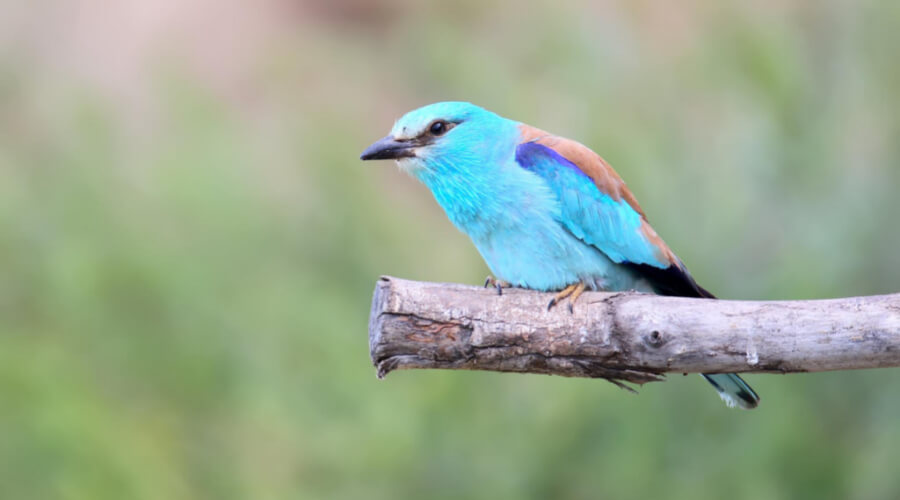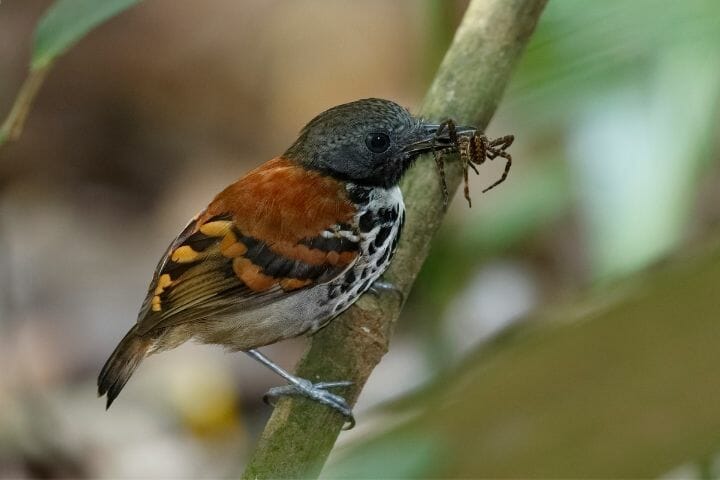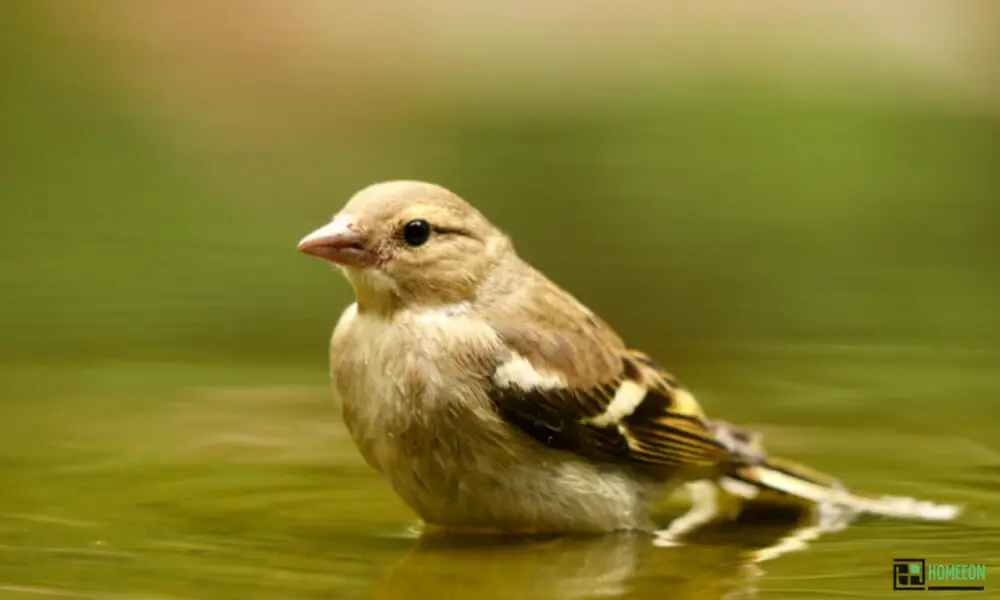Last Updated on July 22, 2023 By Emma W. Thomas
Several bird species consume spiders as part of their diet, helping to control insect populations. For example:
- Black-capped Chickadee
- Carolina Wren
- House Wren
- American Robin
- Northern Mockingbird
- Common Starling
- Gray Catbird
- Barn Swallow
- American Crow
- Northern Cardinal
Types Of Birds That Eat Spiders

Some birds feed on spiders, including;
Sparrows
Sparrows are small birds but very fast in attacking spiders and other insects that they come across. Due to their friendly nature, sparrows live near humans and feed on leftover food. They also pick their nutrition from the ground, including spiders and other insects.
Bluebirds
Bluebirds have brilliant eyesight, which helps them to pounce on grass spiders. Since the birds strike from above, the spiders get little or no time to evade their attack. These tiny and beautiful birds have a distinct sky-blue color and are found in North, Central, and South America.
Bluebirds feed primarily on smaller spiders found on the ground, especially the baby spiders left on their own.
Blackbirds
Spiders are a primary source of food for blackbirds. Blackbirds collect their nutrition from the ground, including tiny crawling organisms such as spiders. These birds are usually found in woody areas and gardens all over the world. Due to their small stature and strong eyesight, blackbirds like preying on smaller and baby spiders.
The birds also carry the spiders to their nests, where they feed their offspring.
Wrens
Wrens are among the smallest bird species in the world. The birds are good at feeding on spiders and insects around the home since they build their nests here. These birds invade the spiders’ nests and eat their eggs and baby spiders, thus helping to keep them at bay. But, these birds are not good at eating more enormous spiders.
Crows
Crows are omnivores that like eating anything they come across, including spiders and other insects. These birds are scavengers and not active hunters, and they mainly prey on insects and spiders at night.
Blue tits
Blue tits feed on spiders when an opportunity strikes. They are the European cousins of the chickadee and are attracted to tinier spiders. The birds like feeding spiders to their chicks by taking them to their nests.
Barn Swallow
These birds are widespread throughout the world, and they like breeding in artificial structures. They are usually found in barns, which is where they got their name. Barn swallows like taking shelter in enclosed spaces where they prey on smaller animals, spiders, and insects. The birds also go outside to look for food to eat.
What types of spiders do birds eat?
Birds play a significant role in controlling spider populations by preying on them. Their diet can be quite varied, but many birds find spiders to be a tasty treat. While not all birds have an appetite for spiders, there are several species that actively seek them out. In this listicle, we will explore some of the types of spiders commonly consumed by birds and the birds that have a fondness for spiders.
- Orb-weaving spiders: These spiders are known for their intricate circular webs. Medially, birds such as robins, thrushes, and blackbirds often feast on these spiders. Birds have developed methods to extract the spider from its web without getting tangled themselves.
- Jumping spiders: This group of spiders is characterized by their impressive leaping abilities. Birds that specialize in capturing insects mid-air, like flycatchers, swifts, and swallows, may occasionally include jumping spiders in their diet.
- Wolf spiders: These ground-dwelling spiders are commonly encountered in grassy areas and gardens. Birds such as sparrows, finches, and warblers that forage near the ground may opportunistically consume wolf spiders.
- Crab spiders: As the name suggests, these spiders resemble crabs with their enlarged front legs. Birds with a penchant for perching on flowers, like hummingbirds, sunbirds, and honeyeaters, are known to prey on crab spiders lurking in the blossoms.
- Funnel-web spiders: These spiders construct horizontally oriented webs with a funnel-shaped retreat. Birds like shrikes, flycatchers, and warblers are capable of finding and extracting these well-camouflaged spiders from their hiding places.
- Huntsman spiders: These large spiders are known for their speed and agility, making them a challenging prey item for birds. However, some larger raptors such as owls and hawks have been known to regularly consume huntsman spiders due to their hunting prowess.
- Nursery-web spiders: These spiders carry their egg sacs with them, attaching them to vegetation until the eggs hatch. Insectivorous birds including warblers and some small thrushes have been observed to consume these spiders.
- Cellar spiders: With their long legs and delicate appearance, cellar spiders are often spotted in dark, damp areas like basements. Birds like wrens and titmice have been documented taking advantage of these spiders when foraging near buildings or in dark corners.
How do birds catch spiders?

Birds catch spiders using various techniques, depending on their species and hunting behavior. Some common methods include:
- Beak Snapping: Birds with sharp, pointed beaks, like robins or wrens, may snap up spiders quickly from vegetation or the ground.
- Probing and Pecking: Birds like chickadees and titmice may probe spider webs or crevices with their beaks and peck at spiders hidden in small spaces.
- Hawking: Insects-eating birds like swallows and flycatchers may catch spiders in mid-air while flying.
- Hovering and Pouncing: Some birds, like hummingbirds, may hover in front of spider webs and pounce on trapped spiders.
- Claw Grasping: Birds of prey, such as hawks and owls, use their sharp talons to catch larger spiders and insects.
- Ground Foraging: Birds like sparrows and thrushes may find spiders on the ground and capture them with a quick peck.
Different Types Of Spiders And How To Identify Them
Some spiders are beneficial since they can feed on other insects, while others are dangerous. Spiders eat aphids, flies, and beetles which are a nuisance in the house and the garden. It is, therefore, vital for you to know how to identify them. The following table shows some of the dangerous types and their distinctive characteristics.
Type Of Spider | Distinctive Features |
Black widow | It has a shiny black or bulging dark-brown abdomen with a red hourglass mark. |
Brown Recluse | Brown in color with a violin-shaped mark on the back |
The Hobo (also known as funnel-web) | They have brown hairy bodies and yellow marks on the abdomen. |
Yellow sac | It has light yellow, pale grey, or light yellowish-green abdomen. The abdomen may sometimes have a rust-colored stripe, and heads are either reddish or rust-colored. |
Which Are Some Of The Natural Ways Of Getting Rid Of Spiders?
Spiders can be a nuisance in your home, especially if you don’t like them. The following are some of the effective ways of eliminating these eight-legged creatures from your home;
Keeping Your Garbage Bins Closed And Far From Your Home
Spiders get attracted to flies, usually around the bins, since they feed on them. Make sure that you place the containers as far away as possible from your house. The bins must also be closed all the time. Doing this helps to keep the spiders away from doors and windows.
Switching Off Outdoor Lights
Since light attracts insects, spiders will also get attracted to feed on them. Keeping your lights off at night will deter both the insects and their predators – the spiders.
Having A Cat
Cats are good at hunting insects, and spiders are no exception. Using a cat is one of the most efficient and safest ways to eliminate spiders without using chemicals.
Using Horse Chestnuts (Conkers)
Using conkers or horse chestnuts is another excellent natural way of eliminating spiders from your home. These substances are believed to contain some chemicals that spiders dislike. You can place the horse chestnuts in places with high spider traffic, especially at the corners.
If possible, you can make some holes in the conkers to release more chemicals. While this method is not a guarantee, it is worth trying.
Use Of Cinnamon
Spiders don’t like the strong scent of cinnamon, and you can use this product to deter them. You can burn a cinnamon candle in your home every night to keep spiders at bay.
Application Of Lemon Peels
Lemon peels are also an excellent remedy when getting rid of spiders in your home. Rubbing lemon peels on surfaces, bookshelves, windowsills, and any other place where spiders hide can help eliminate them. Lemon has a citrus, which the eight-legged insects hate.
Using White Vinegar
White vinegar is a natural spider repellent that works effectively to keep away spiders. Mix vinegar with water in equal portions in a spray bottle and apply the mixture all around your house, including the crevices and cracks on walls, windows, and doors. The acetic acid contained in vinegar is believed to burn and kill spiders when they come into contact with it.
Cleaning Up Your Home
Spiders love hiding in cluttered areas in your home. You can remove any dust, vacuum your home, and remove all clutter. Doing this will help to remove any webs and deny these creatures a hiding place. Ensure that you regularly clean your home to eliminate any new traps and prevent them from building others.
Sealing any cracks is necessary since spiders get into your house through cracks. It is essential to seal up any entry points. You can use sealant to cover all crevices and tiny holes around the windows, doors, and walls.
Conclusion
Many bird species around the world eat spiders as their primary source of food. While most birds go after tiny spiders, others eat even more giant spiders. It is necessary to know the bird species to attract to your homes to eliminate the spider menace.
References:
https://birdfact.com/articles/do-birds-eat-spiders
https://www.outlifeexpert.com/which-birds-eat-spiders/
Emma is a graduate of Domestic Science or Family and Consumer Sciences (Home Economics) from the University of Wisconsin. She has 7 years of experience Working with the strategic section of BestBuy and now writing full-time for Homeeon.
From Managing the Home, Interiors, Cleaning, and Exteriors to Gardening and everything about Making A Home Liveable – is her passion and this Homeeon is the result of this.
Emma loves decorating her home with the best stuff found online. She cares about quality over anything and writes reviews about them here in Homeeon. Get in touch with her over Pinterest.
Keep reading her blogs.

